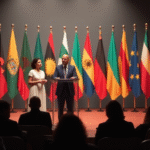Background and Key Players
The United States, through the Treasury Secretary Scott Bessent, is negotiating a $20 billion swap with Argentina. This announcement follows a bilateral meeting between Javier Milei and Donald Trump, where Trump reaffirmed his strong support for the libertarian president.
Javier Milei, Argentina’s president, expressed gratitude for the political support provided by the United States. Meanwhile, Wall Street has shown mixed reactions, with analysts and economists expressing skepticism about the swap’s long-term benefits.
Details of the Swap
According to Bessent, the US Treasury is ready to purchase Argentine bonds in dollars under certain conditions and is prepared to grant a significant stand-by credit through the Exchange Stabilization Fund. The US is also willing to buy Argentine government debt, secondary or primary, and work with the Argentine government to end tax exemptions for raw material producers converting foreign currency.
Numerous US companies reportedly plan substantial foreign direct investments in Argentina across various sectors, contingent on a favorable electoral outcome.
Analysts’ Concerns and Criticisms
Adam Kobeissi, founder of The Kobeissi Letter, emphasized that Argentina’s economy requires more substantial reforms. He stated that while the Trump administration has offered a financial lifeline, deeper issues persist. Argentina should allow the peso to float freely, cut spending, and ensure the independence of the Central Bank.
Robin Brooks, former chief economist at the Institute of International Finance (IIF), bluntly described Argentina’s situation: “Argentina keeps replaying the same movie: devaluation, revaluation, overvaluation, and eventual parity explosion. We’re currently in the overvaluation phase. It’s a bad movie. Stop watching it!”
Potential Impact and Risks
The swap appears more like a temporary financial bridge to elections rather than a lasting solution. Analysts warn that without fiscal discipline, an independent Central Bank, and a realistic exchange rate, this lifeline could become another chapter in Argentina’s recurring financial drama.
Morgan Stanley suggests the measure could cover critical 2026 obligations, prevent a sharp decline in Central Bank reserves, and reduce external default risk. However, the investment bank’s report cautions that dependence on fresh dollars leaves Argentina vulnerable if assistance doesn’t meet expectations, potentially triggering capital flight and peso pressure.
J.P. Morgan views the Treasury’s support as a crucial political and financial signal.
Existing Swap with China
This proposed $20 billion swap with the EU comes as Argentina already has an existing swap with China. In 2023, the BCRA reached an agreement with the People’s Bank of China to extend a currency swap for another year, postponing Argentina’s payment obligations of $5 billion by a year.
In January 2022, Argentina expanded its swap with China, allowing it to include approximately $20.6 billion (130,000 million yuan) in its reserves. This agreement’s origins trace back to April 15, 2009, when both central banks committed to a $10.2 billion swap (equivalent to 70,000 million yuan or $38 billion pesos).
In 2014, another swap was signed between the presidents of the monetary authorities of both countries for $11 billion. At that time, Argentina’s international reserves amounted to $29.519 billion.
Key Questions and Answers
- What is the proposed swap amount between Argentina and the US? The proposed swap is $20 billion.
- Who are the key figures involved in these negotiations? The United States, represented by Treasury Secretary Scott Bessent, and Argentina’s President Javier Milei are the main parties.
- What are analysts’ concerns about this swap? Analysts warn that without fiscal discipline, an independent Central Bank, and a realistic exchange rate, this swap could become another temporary financial bridge rather than a lasting solution.
- What is Argentina’s existing swap agreement with China? Argentina has a swap agreement with China that allows it to postpone payment obligations and include Chinese yuan in its reserves. The current agreement was initiated in 2009 and expanded in 2014 and 2022.






